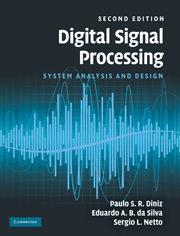Book contents
- Frontmatter
- Contents
- Preface
- Introduction
- 1 Discrete-time signals and systems
- 2 The z and Fourier transforms
- 3 Discrete transforms
- 4 Digital filters
- 5 FIR filter approximations
- 6 IIR filter approximations
- 7 Spectral estimation
- 8 Multirate systems
- 9 Filter banks
- 10 Wavelet transforms
- 11 Finite-precision digital signal processing
- 12 Efficient FIR structures
- 13 Efficient IIR structures
- References
- Index
9 - Filter banks
Published online by Cambridge University Press: 05 June 2012
- Frontmatter
- Contents
- Preface
- Introduction
- 1 Discrete-time signals and systems
- 2 The z and Fourier transforms
- 3 Discrete transforms
- 4 Digital filters
- 5 FIR filter approximations
- 6 IIR filter approximations
- 7 Spectral estimation
- 8 Multirate systems
- 9 Filter banks
- 10 Wavelet transforms
- 11 Finite-precision digital signal processing
- 12 Efficient FIR structures
- 13 Efficient IIR structures
- References
- Index
Summary
Introduction
In Chapter 8 we dealt with multirate systems in general; that is, systems in which more than one sampling rate coexist. Operations of decimation, interpolation, and sampling-rate changes were studied, as well as some filter design techniques using multirate concepts.
In a number of applications, it is necessary to split a digital signal into several frequency bands. After such decomposition, the signal is represented by more samples than in the original stage. However, we can attempt to decimate each band, ending up with a digital signal decomposed into several frequency bands without increasing the overall number of samples. The question is whether it is possible to recover the original signal exactly from the decimated bands. Systems which decompose and reassemble the signals are generally called filter banks.
In this chapter, we deal with filter banks, showing several ways in which a signal can be decomposed into critically decimated frequency bands, and recovered from them with minimum error. We start with an analysis of M-band filter banks, giving conditions for perfect reconstruction. Then we perform both frequency- and time-domain analyses of filter banks, followed by a discussion on orthogonality. We also treat two-band perfect reconstruction filter banks, and present the special designs for quadrature mirror filters (QMFs) and conjugate quadrature filters (CQFs). In addition, we shift to M-band filter banks, analyzing block transforms, cosine-modulated filter banks, and lapped transforms.
- Type
- Chapter
- Information
- Digital Signal ProcessingSystem Analysis and Design, pp. 503 - 598Publisher: Cambridge University PressPrint publication year: 2010

